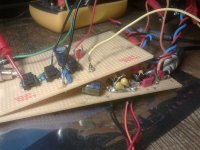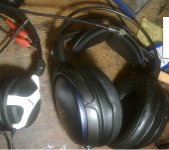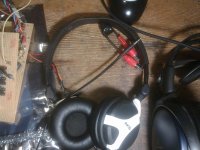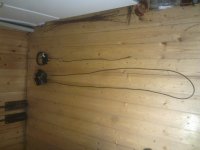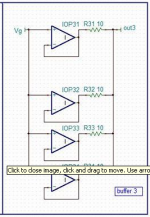It's not a matter of linearity (well, unless your amp FR depends heavily on the phase of the load).
The Z of the load is a complex number, and adding a series resistor (whose Z is a pure real number - phase == 0), lowers the phase (lowers the imaginary part WRT the real one) of the load seen by the amp.
This matters for amp designs with NFB, since the NFB signal is applied of out phase WRT the input signal (and at 180deg you got yourself a self sustained oscillator ).
).
The Z of the load is a complex number, and adding a series resistor (whose Z is a pure real number - phase == 0), lowers the phase (lowers the imaginary part WRT the real one) of the load seen by the amp.
This matters for amp designs with NFB, since the NFB signal is applied of out phase WRT the input signal (and at 180deg you got yourself a self sustained oscillator
Everything Ice said is true. Phase margin must be considered for stability reasons. And its effect on the feedback loop can cause nonlinearity. Of course we strive to design around this criteria.
But also, reducing the load on your output stage with a series resistor can make your output stage more linear, which will reduce distortion. This is especially true when trying to drive low impedance cans (like 32 or 64 ohms) with an op amp, which is rated into 600 ohms. You can get it to work, you can parallel them; I've prototyped various configurations and it's hard to beat an op amp based circuit with an LME49600 buffer. Of course you can beat that with a complex discrete circuit, but you can put the buffered circuit on a fairly small board. BUF634 works great too and is even smaller (DIP-8 package) and doesn't even get warm driving 32 ohm cans with a 20 volt single ended supply.
But also, reducing the load on your output stage with a series resistor can make your output stage more linear, which will reduce distortion. This is especially true when trying to drive low impedance cans (like 32 or 64 ohms) with an op amp, which is rated into 600 ohms. You can get it to work, you can parallel them; I've prototyped various configurations and it's hard to beat an op amp based circuit with an LME49600 buffer. Of course you can beat that with a complex discrete circuit, but you can put the buffered circuit on a fairly small board. BUF634 works great too and is even smaller (DIP-8 package) and doesn't even get warm driving 32 ohm cans with a 20 volt single ended supply.
AKG headphones: 32R per channel.
Technics: 40R per channel.
Today, i listened carefully to SC 2005 one channel.
100R series resistance, 4x gain.
Still, not kinda good what i was expecting it to be.
I hooked up AKG to SC 2005, despite they'r unique sound quality , they were still more comfortable to listen.
, they were still more comfortable to listen.
Next:
This buffer was tested with a square wave i belive:
NO OVERSHOOTS AT ALL.
1) AKG headphone grounds are SEPARATED from 3.5mm jack.
WIRE: 1 meter long.
2)Technics headphones, i belive grounds are separated in the right speaker cabinet.
WIRE: 3 meter long.
I suspect, that all these configurations that i have tried are unstable into audio technics headset ? ...
Even with the Lenovo T410 laptop, Audio Technics played there well
Technics: 40R per channel.
Today, i listened carefully to SC 2005 one channel.
100R series resistance, 4x gain.
Still, not kinda good what i was expecting it to be.
I hooked up AKG to SC 2005, despite they'r unique sound quality
Next:
- removed the gain stage from the opamp buffers.
- Soldered 3xOPA2134 to the TIDU034 active volume output via 550R resistor.
- Removed buffer output series 100R resistor(texas gain is very low), EXACT buffer configuration is on the last picture.
- Hooked up AKG´s, everything is OK(by that i mean, no unpleasant distortion at high volumes).
- Hooked up Technics, @ low volume is OK, high is still messed up to me.
- Tried with 100R on the output, better, considering that Texas gain is set around 1.5X
This buffer was tested with a square wave i belive:
Response of buffer #3 to a 10 kHz square ware, 100 kHz band limited :
NO OVERSHOOTS AT ALL.
1) AKG headphone grounds are SEPARATED from 3.5mm jack.
WIRE: 1 meter long.
2)Technics headphones, i belive grounds are separated in the right speaker cabinet.
WIRE: 3 meter long.
I suspect, that all these configurations that i have tried are unstable into audio technics headset ? ...
Even with the Lenovo T410 laptop, Audio Technics played there well
Attachments
You can increase the value of the swamping resistors instead of using series resistors. I think this would work better.
Choose their value like this. If you're shooting for 100 ohms series resistance with 4 parallel buffers, use 400 ohm swamping resistors. See how that works?
And I'll say it again: you will hear every flaw in every source and every mix if you use a super precision headphone amp that operates directly from the source. Many flaws that you would never hear through speakers or a low resolution sound card driving headphones directly will become quite apparent. MP3 files can be quite bad (although some are quite good) and really sound better through a mediocre sound system. Even some CDs fall in this category, in my opinion.
Choose their value like this. If you're shooting for 100 ohms series resistance with 4 parallel buffers, use 400 ohm swamping resistors. See how that works?
And I'll say it again: you will hear every flaw in every source and every mix if you use a super precision headphone amp that operates directly from the source. Many flaws that you would never hear through speakers or a low resolution sound card driving headphones directly will become quite apparent. MP3 files can be quite bad (although some are quite good) and really sound better through a mediocre sound system. Even some CDs fall in this category, in my opinion.
You can increase the value of the swamping resistors instead of using series resistors. I think this would work better.
Choose their value like this. If you're shooting for 100 ohms series resistance with 4 parallel buffers, use 400 ohm swamping resistors. See how that works?
Yes, that was crossing my mind back when we figured out the series resistance trick
I try that tommorow....
Another solution:
I also have 4 amplifier boards of old 82's HIFI(u101 amplifier), 1 works, 3 boards are damaged....but another one will be fixed for completed stereo in future.
I will try one board as mono first ?
Board is rated @ 20W into 4 ohm. Which value of resistance is needed to try HEADPHONES on speaker amplifier output ?
They are quite compact in size and if sound is good, i can easily adapt them into preamp chassis
EDIT: this is schematic of a 82's HIFI amplifier board:
http://www.hot.ee/jannoke/u01-2_crop.jpg
Last edited:
Okey, i have tried 330R on each opamp output = totalling 6x330R. 3xOPA2134 chips.
I noticed output DC drop into 0.1-0.0mV.
Soundwise, in one channel only, its same as before(100R output series), so no big cure from slight overshoots.
BUT, @ low volume... it was more interesting to listen to music... i kept headphones on for a longer time
100R series output trick was the most noticable improvement curing OVERSHOOTS.
Maybe my explanation is not accurate enaugh of a real situation that has been going on since i started the thread:
Its not about a bad or good recording.... this overshoot happens to be on the EXACT frequency range.... To me, it seems that this Exact frequency is amplified too much for Audio Technics.....
Maybe with switchable crossfeed it can be attenuated to a comfortable listening level ?
EDIT: For example: Lenovo T410 win7, if Technics are hooked up, Sound chip drivers recognizes the headphones and thats the point were "digital" filters are entering into the sound path ?
U are right, i do not hear the fresh and "airness" in the music with T410, but atleast i can crank it up to 100% volume without taking the headphones off the head
I noticed output DC drop into 0.1-0.0mV.
Soundwise, in one channel only, its same as before(100R output series), so no big cure from slight overshoots.
BUT, @ low volume... it was more interesting to listen to music... i kept headphones on for a longer time
100R series output trick was the most noticable improvement curing OVERSHOOTS.
Maybe my explanation is not accurate enaugh of a real situation that has been going on since i started the thread:
Its not about a bad or good recording.... this overshoot happens to be on the EXACT frequency range.... To me, it seems that this Exact frequency is amplified too much for Audio Technics.....
Maybe with switchable crossfeed it can be attenuated to a comfortable listening level ?
EDIT: For example: Lenovo T410 win7, if Technics are hooked up, Sound chip drivers recognizes the headphones and thats the point were "digital" filters are entering into the sound path ?
U are right, i do not hear the fresh and "airness" in the music with T410, but atleast i can crank it up to 100% volume without taking the headphones off the head
Last edited:
If you don't do the grounds right, then the very best circuit can perform poorly.
I fell foul of this on a USB mixer I designed.
I just laid out the tracks as they came out of the schematic to pcb converter.
I powered it up and had 1 volt pk to pk hum on the output.
I tracked it down to smoothing capacitor charging impulses getting into the audio ground.
So I re-laid it out keeping audio and power supply grounds totally separate only joining at the pcb edge once (star ground).
This time there was negligable hum on the output.
I learned a lot from that one project about grounding techniques.
Okey guys, i think i got it
u101 sounds so different from all the opamps/buffer combinations.
Fired one channel UP, 100R series resistor and 470uF 35V cap on the output(i got scared of 63mV DC on output).
u101 needs two supplies(front-end 32V and output 25V).
The output quiesent current potentiometer was rusty, got it to work too, Set the output to 11mA
Its sounds nice, overshoots are minimized, i could blow out my eardrums before i hear anything unpleasant from music.
Bass is there, kicking and slamming hard...
https://www.youtube.com/watch?v=NivCtDym138
Check this crazy video out.
There will be another channel ready, i will then post stereo results.
EDIT: I feel that now we have another dilemma, is there a neat way to remove 100R resistor from output and not blow the headphones up ??
Rene
u101 sounds so different from all the opamps/buffer combinations.
Fired one channel UP, 100R series resistor and 470uF 35V cap on the output(i got scared of 63mV DC on output).
u101 needs two supplies(front-end 32V and output 25V).
The output quiesent current potentiometer was rusty, got it to work too, Set the output to 11mA
Its sounds nice, overshoots are minimized, i could blow out my eardrums before i hear anything unpleasant from music.
Bass is there, kicking and slamming hard...
https://www.youtube.com/watch?v=NivCtDym138
Check this crazy video out.
There will be another channel ready, i will then post stereo results.
EDIT: I feel that now we have another dilemma, is there a neat way to remove 100R resistor from output and not blow the headphones up ??
Rene
Last edited:
Its not about a bad or good recording.... this overshoot happens to be on the EXACT frequency range.... To me, it seems that this Exact frequency is amplified too much for Audio Technics.....
It's the headphones. There is probably a "magic" resistor value that will mitigate it.
EDIT: I feel that now we have another dilemma, is there a neat way to remove 100R resistor from output and not blow the headphones up ??
This is way overkill. You say it sounds smoother, but it's like driving a tack with a jackhammer. I already asked you if you could run it off a lower supply. That might not even work with this amplifier. I use 20 volt supplies with my headphone amps and I make them single ended (best cheap headphone protection!).
You're going to do best with the right headphone amplifier. A buffered op-amp based circuit will blow away anything you're tinkering with, and it will have a lower parts count too. Try BUF634, or if you don't mind surface mount then the LME49600 buffer is very superior. Then you can find the right resistor etc, have all the versatility you desire, and you will be happy.
Given a low-impedance output, ATH-AD900s have a rather "'90s open headphone" kind of sound signature, not too dissimilar from the old Sennheiser HD545/565 or the low-bass version of the HD595 (look up their measurements). There's a certain bass deficiency and a slightly ascending frequency response from bass to upper midrange, and it looks like it would be brighter than the Senns up top. Their impedance variation can't make up for the skewed FR, even an almost ideal current source output only gives 1.58 dB of bass boost where you could easily use at least 3.
(BTW, the new ATH-R70x is almost the exact opposite, rather bassy.)
I would think that the longer cable of the ATs is tripping your amplifiers up. A 3 m Sennheiser cable showed close to 1 nF of capacitance here. When testing for stability, I'd go up to at least 10 nF if lower values have proven stable.
BTW, the company's name is Audio Technica, nothing to do with Technics / Panasonic.
(BTW, the new ATH-R70x is almost the exact opposite, rather bassy.)
I would think that the longer cable of the ATs is tripping your amplifiers up. A 3 m Sennheiser cable showed close to 1 nF of capacitance here. When testing for stability, I'd go up to at least 10 nF if lower values have proven stable.
BTW, the company's name is Audio Technica, nothing to do with Technics / Panasonic.
- Status
- This old topic is closed. If you want to reopen this topic, contact a moderator using the "Report Post" button.
- Home
- Amplifiers
- Headphone Systems
- Amp matching to headphones
